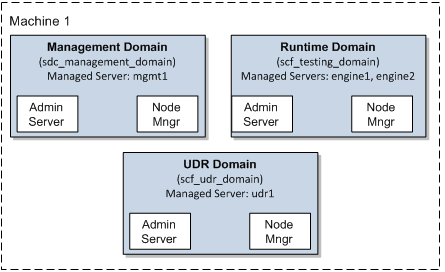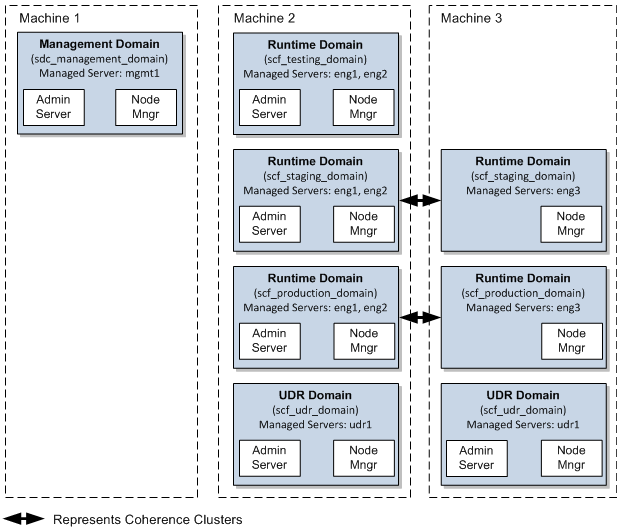2 Planning Your OCECAS Installation
This chapter provides information about planning your Oracle Communications Evolved Communications Application Server (OCECAS) installation.
About Planning Your OCECAS Installation
When planning an OCECAS installation, consider how many physical servers can handle your subscriber base and how many OCECAS nodes to include in your cluster.
Oracle recommends that your production pipeline has a testing, staging, and production system, with each one on a different machine.
The difference between an OCECAS development system and an OCECAS production system is only the number of machines in the system. You install the same components in a test system that you install in a production system.
See "OCECAS System Requirements" for information about required hardware and software.
Your OCECAS installation must also include an ECAS subscriber server (ESS) to store some subscriber information and some internal data. For details on planning your subscriber stores, see ”About Managing and Using Subscriber Data” in Enhanced Communications Application Server Concepts.
Planning Your Installation
The following section describes the recommended OCECAS installation topologies.
Understanding Installation Topologies
Figure 2-1 shows a simple OCECAS installation topology that consists of one machine with three domains: a management domain, a single runtime domain, and an UDR domain. This topology is useful for demonstration or evaluation purposes, or in cases with limited resources (that is, limited CPU and memory).
Figure 2-1 Simple OCECAS Installation Topology

Description of "Figure 2-1 Simple OCECAS Installation Topology"
While a simple OCECAS topology is sufficient for development and Proof of Concept (PoC) installations, production systems must be robust and fault-tolerant.
Figure 2-2 shows a fault-tolerant OCECAS installation topology. In this topology, multiple machines are used to host clustered resources.
Figure 2-2 Fault-Tolerant OCECAS Installation Topology

Description of "Figure 2-2 Fault-Tolerant OCECAS Installation Topology"
Each element in this topology illustration is described in Table 2-1.
Table 2-1 Description of the Elements in the OCECAS Standard Installation Topology
| Element | Description and Links to Additional Documentation |
|---|---|
|
OCECAS Domain |
A logically related group of Java components (in this case, the Administration Server, managed servers, and other related software components). For more information, see "Understanding Domains" in Oracle Fusion Middleware Understanding Oracle WebLogic Server. |
|
Administration Server |
The central control entity of a domain, which maintains the domain's configuration objects and distributes configuration changes to managed servers. For more information, see "Administration Server" in Oracle Fusion Middleware Understanding Oracle WebLogic Server. |
|
Cluster |
A collection of multiple OCECAS instances running simultaneously and working together. For more information, see "Managed Servers and Managed Server Clusters" in Oracle Fusion Middleware Understanding Oracle WebLogic Server. |
|
Node Manager |
Node Manager is a WebLogic Server utility that enables you to start, shut down, and restart Administration Server and managed server instances from a remote location. Although Node Manager is optional, it is recommended if your WebLogic Server environment hosts applications with high availability requirements. For more information, see "Running Node Manager as a Startup Service" in Oracle Fusion Middleware Understanding Oracle WebLogic Server. |
|
Machine |
A logical representation of the computer that hosts one or more WebLogic Server instances (servers). Machines are also the logical glue between OCECAS managed servers and the Node Manager; to start or stop a managed server with Node Manager, the managed server must be associated with a machine. |
|
Managed Server |
The host for your applications, application components, Web services, and their associated resources. For more information, see "Managed Servers and Managed Server Clusters" in Understanding Oracle WebLogic Server. |
OCECAS Coherence Planning
OCECAS nodes are based on Oracle Coherence. Decide how to configure Oracle Coherence settings for your OCECAS topology, for example, how many nodes to add to the cluster when a node failure occurs. For more information, see "Configuring and Managing Coherence Clusters" in Oracle Fusion Middleware Administering Clusters for Oracle WebLogic Server.
About the OCECAS Domains
An OCECAS implementation requires a set of WebLogic domains. Together they comprise a deployment pipeline that you use to develop, stage, and finally deploy multimedia services for your subscribers to use. For more information, see ”About Change Management and the Production Pipeline” in Evolved Communications Application Server Concepts.
If you are creating a test, demonstration, or evaluation implementation, you can install these domains, or a combination of them, on the same physical or virtual system. A production implementation normally requires a separate WebLogic machine for each domain. Each OCECAS implementation requires these domains:
-
Management Domain
You use the management domain to administer all other domains. You run the Session Design Center (SDC) GUI on this domain. You must install the Oracle database software and run the root.sh script on the same machine that hosts this domain.
-
Testing Domain (Runtime Domain)
You use the testing domain to develop new services and implementation changes. You create a testing domain by using the runtime domain template. You can cluster this domain across multiple WebLogic machines, if required.
Each runtime domain requires access to a UDR component. The UDR component can be co-located with the runtime domain, located in another runtime domain, or deployed into a domain of its own.
-
Staging Domain (Runtime Domain)
You use the staging domain to test the changes you created in the testing domain. You create a staging domain by using the runtime domain template.
Each runtime domain requires access to a UDR component. The UDR component can be co-located with the runtime domain, located in another runtime domain, or deployed into a domain of its own.
-
Production Domain (Runtime Domain)
Your subscribers access services on the production domain. On clustered systems, one production domain spans two clustered WebLogic machines with the UDR domain on a separate machine.
Each runtime domain requires access to a UDR component. The UDR component can be co-located with the runtime domain, located in another runtime domain, or deployed into a domain of its own.
-
(Optional) UDR Domain
You use the User Data Repository (UDR) domain to store some subscriber data in an ECAS subscriber server (ESS). You create a UDR domain by using the UDR domain template.
An ESS is required, but it does not have to be in a dedicated UDR domain. You can also store it in a runtime domain, or on its own. See ”About Managing and Using Subscriber Data” in Enhanced Communications Application Server Concepts for more information.
Table 2-2 describes each OCECAS domain.
Table 2-2 Domains Required by OCECAS
| Domain Type | Domain Template to Use | Default Name and Location |
|---|---|---|
|
Management Domain |
Management Domain |
Ocecas_home/user_projects/domains/sdc_management_domain |
|
Testing Domain |
Runtime Domain |
Ocecas_home/user_projects/domains/scf_testing_domain (required; see "Configuration Type Screen") |
|
Staging Domain |
Runtime Domain |
Ocecas_home/user_projects/domains/scf_staging_domain (required; see "Configuration Type Screen") |
|
Production Domain |
Runtime Domain |
Ocecas_home/user_projects/domains/scf_production_domain (required; see "Configuration Type Screen") |
|
UDR domain |
UDR Domain |
Ocecas_home/user_projects/domains/scf_udr_domain |
Understanding Port Numbering
For a production OCECAS implementation, you must change the default port numbers. See "Securing Ports" in Evolved Communications Application Server Security Guide for a list of the default port numbers and their security implications.
For a test and evaluation system, you can use the default port numbers if you install each domain on its own system. However, you will probably install more than one domain on a single system. In that case, ensure that the various ports for each domain are unique within that system. This includes:
-
Administration Server listening ports
-
Administration Server SSL ports
-
Node Manager Ports
-
Management Server mgmt1 listening ports
-
Management Server SSL listening ports
-
Runtime Domain engine listening ports
-
Runtime Domain engine SIP channel ports
-
Runtime Domain engine SIPs channel ports
-
Runtime Domain cluster unicast ports
About Installing a Secure System
In a production system, ensure that communication between components and access to the system servers are secure. For information about choices for installing a secure system, see "Performing a Secure OCECAS Installation" in Evolved Communications Application Server Security Guide.